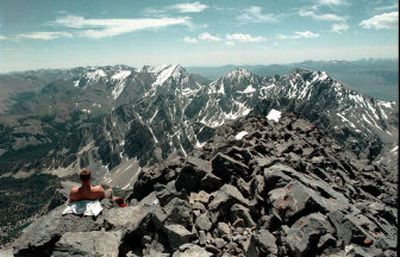Quest for a real high

High on Mount McKinley in the summer of 2003, stuck in a cramped mountaineering tent and waiting out a storm, John Mitchler took out a pencil to write a list. Wind tore into the nylon fabric above his head. The end was coming for Mitchler, he was sure.
“I decided to write a list of all the people I’d climbed with over the years,” he said. “McKinley was to be my final mountain.”
Mitchler didn’t perish on that high Alaskan peak. Indeed, his party soon made the mountain’s 20,320-foot summit.
But for the 50-year-old geologist from Golden, Colo., Mount McKinley did signify the end of a personal quest: For more than 20 years, Mitchler had traveled the country climbing peaks and hiking hills to stand at the highest point of elevation in each of the 50 states.
Highpointing, as this state-by-state summit-seeking pursuit is called, has garnered a following of more than 10,000 people, according to Roger Rowlett, chairman of the Highpointers Club ( www.highpointers.org) , which was founded in 1988. Every state has a highest point of elevation, be it a towering mountain peak or a nondescript knoll in a cornfield. To highpointers, each one of these summits is geographically significant.
“You need advanced mountaineering skills for peaks like Mount Rainier (in Washington state) and McKinley,” Rowlett said. “But completing the list also means traveling thousands of miles through obscure parts of the country.”
To check off Florida, for example, highpointers drive to Britton Hill, a meager slope in the Panhandle with an elevation of just 345 feet above sea level. In Illinois, a state of cornfields and prairie, a 1,235-foot rise called Charles Mound is the destination. Rhode Island’s Jerimoth Hill tops out at 812 feet above the nearby Atlantic waters.
More than a dozen states, including Kansas, Kentucky and Ohio, have highpoints with road access, letting people essentially drive to the summit. Wyoming’s Gannett Peak, in contrast, requires up to 50 miles of roundtrip backcountry hiking in the remote Wind River Mountain Range.
To date, 155 people are on record as having completed all 50 highpoints, according to Rowlett. Roughly 10 new people a year climb their 50th state summit and are added to the Highpointers Club’s list of completers. Plaques are awarded.
Wilderness adventure is an obvious allure for highpointers. But the pursuit also attracts goal-motivated individuals who savor keeping a checklist and marking off each highpoint they reach.
“There’s something tangible and satisfying about having a list to check off,” said Roger Truesdale, a 62-year-old retired physical-education teacher from Bloomington, Minn. He has climbed all 50 highpoints, 49 of them with his wife, Jane.
“Highpointing gives you well-defined goals, and many people like that.”
The Truesdales, who started their highpointing quest in 1988, took road trips during the summer months to climb several state highpoints at once. On one trip through the Midwest, they hit 10 summits over a couple weeks. They did the same in New England, driving to the top in flatter states and hiking Appalachian trails in states like Vermont to climb eight peaks on one vacation.
Frozen toes and altitude sickness are a real danger on a dozen states’ summits.
Going to the extreme is not a highpointing requirement, however. Indeed, most of the 50 highpoints are moderate hikes with elevations of less than 7,000 feet. And climbing all 50 peaks is not the goal of every highpointer. Some make a goal to see the country, and ascend 20 or 30 highpoints with no serious mountaineering involved. Families with young children may schedule a road-trip vacation around highpoint destinations.
In many states, including Minnesota, South Dakota, Vermont, Virginia and Maryland, the summits involve moderate half-day hikes that require just enough effort to provide a sense of accomplishment.
Harney Peak, the 7,242-foot highpoint near Mount Rushmore in South Dakota, for example, necessitates a 6-mile roundtrip hike in the scenic Black Hills wilderness. Hikers pass through dense pine forests and vertical spires of granite on their way to the top. The trail gains about 1,500 vertical feet of elevation from the parking lot. Bighorn sheep and mountain goats may be sighted along the way.
Like John Mitchler and many other highpointers, Roger Truesdale saved the most difficult climb for last. He scaled Mount McKinley, his 50th summit, last summer. A storm stranded his group for five days, and they hung out in tents and built snow walls to protect the camp from wind.
After the storm passed, Truesdale and his team climbed to the top in an eight-hour push from a high camp at 17,000 feet.
“It was an awesome way to end the journey,” he said.